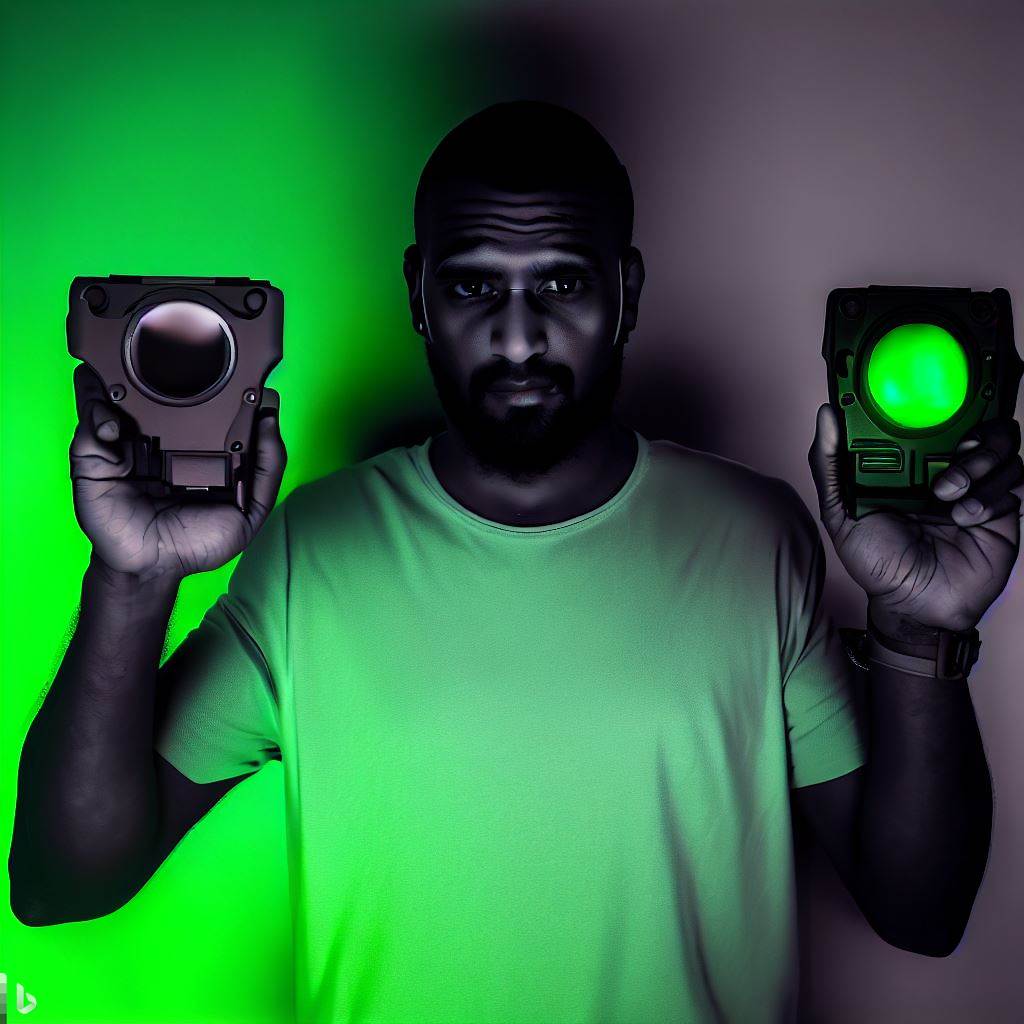

Night vision technology has revolutionized the way we see in the dark, and it comes in different shades – green and black-and-white. But what sets these two apart?
In this article, you will uncover the distinctions between green and black-and-white night vision, shedding light on their unique features, applications, and the factors that make them stand out in the realm of nocturnal visibility.
Whether you’re a curious night owl or someone seeking the best night vision equipment, this exploration will unveil the secrets behind the captivating hues of night vision imagery.
Introduction
Night vision technology has revolutionized the way we see and perceive our surroundings in low-light or pitch-dark conditions. Whether it’s for military operations, surveillance, or nocturnal activities, night vision has become an invaluable tool.
While there are various types of night vision available, green and black-and-white are two of the most common options.
In this article, we will explore the differences between green and black-and-white night vision, including their working principles, advantages, disadvantages, and application areas.
By the end, you’ll have a clear understanding of which night vision technology suits your needs best.
Overview of Night Vision
Definition of night vision
Night vision refers to the ability to see in low-light or dark environments where our eyes would naturally struggle to perceive details. Night vision technology amplifies the available light, including dim natural light or infrared, and intensifies it to produce a clearer and brighter image.
Importance of night vision technology
Night vision technology plays a crucial role in numerous fields, such as military operations, law enforcement, wildlife observation, surveillance, navigation, and even recreational activities like hunting and camping.
By enabling individuals to see in the dark, night vision provides an extra layer of safety, enhances situational awareness, and allows for covert operations.
Evolution of night vision
Night vision technology has come a long way since its inception. Early night vision devices utilized image intensification tubes and produced black-and-white images. However, as technology progressed, advancements were made in color imaging. Green and black-and-white night vision are the two primary options commonly used today.
Green Night Vision
Explanation of green night vision
Green night vision, also known as green phosphor night vision, is a type of night vision that utilizes a green-tinted image rather than black-and-white. The green color is a byproduct of the phosphor screen inside the night vision device.
Working principle of green night vision
Green night vision operates on a principle called “P43” or “P45.” It uses a P43 or P45 phosphor screen to convert incoming light into a green image, which is then amplified and displayed on the screen. The green color is preferred due to its high contrast sensitivity, making it easier for the human eye to distinguish objects and details in low light.
Advantages of green night vision
One of the significant advantages of green night vision is its ability to provide a more natural viewing experience. The human eye is more sensitive to green light, making green night vision images easier to perceive and interpret. Additionally, green night vision offers better contrast sensitivity, allowing for enhanced object recognition in various environments.
Disadvantages of green night vision
Despite its advantages, green night vision does have a few drawbacks. One of the main concerns is that the green color can create a slightly distorted perception of reality. This can be an issue in situations that require precise color identification or when using night vision in conjunction with other equipment that provides true color representation.
Black-and-white Night Vision
Explanation of black-and-white night vision
Black-and-white night vision, also known as monochrome night vision, produces images in shades of gray. This technology was one of the earliest forms of night vision and is still in use today, although it has been overshadowed by advancements in color imaging.
Working principle of black-and-white night vision
Black-and-white night vision operates using an image intensification tube that amplifies available light and converts it into electrons. These electrons strike a phosphor screen, which emits a green image that is then filtered to appear as black-and-white. The final image appears in shades of gray, with darker shades representing areas with less light.
Advantages of black-and-white night vision
Black-and-white night vision offers some advantages over green night vision. Since it produces images solely in shades of gray, it can provide a more realistic representation of light and shadows. In situations where accurate depth perception is crucial, black-and-white night vision performs better than green.
Disadvantages of black-and-white night vision
One of the major drawbacks of black-and-white night vision is the reduced contrast sensitivity compared to green night vision. The grayscale images can make it more difficult to distinguish objects, especially in low-contrast environments. Additionally, black-and-white night vision may cause more eye fatigue due to the lack of color.
Comparison Between Green and Black-and-white Night Vision
Image Quality
In terms of image quality, green night vision generally outperforms black-and-white night vision. The green color provides better contrast sensitivity, allowing for clearer and more detailed images. Black-and-white night vision, on the other hand, can lack detail due to the absence of color information.
Clarity
When it comes to clarity, both green and black-and-white night vision can provide a clear view of the surroundings. However, green night vision has an advantage here as the human eye is more sensitive to green light, making it easier to perceive details even in low-light conditions.
Contrast
Green night vision excels in contrast sensitivity, offering better differentiation between objects and their backgrounds. This makes it easier to spot and recognize objects in various environments, especially when there is a low contrast between the object and its surroundings. Black-and-white night vision may struggle to provide the same level of contrast.
Visibility in Different Environments
In general, both green and black-and-white night vision perform well in a wide range of environments. Green night vision tends to be more suitable in forested or vegetated areas, as the green phosphor produces images that blend better with the surroundings.
On the other hand, black-and-white night vision may be more advantageous in environments where depth perception is essential, such as urban areas or situations requiring precise object identification.
Eye Fatigue
Using green night vision may result in less eye fatigue compared to black-and-white night vision. The human eye is naturally more sensitive to green light, making it easier to view for extended periods without experiencing significant strain or fatigue. Black-and-white night vision may cause more eye fatigue due to the lack of color information.
Power Consumption
In terms of power consumption, both green and black-and-white night vision devices are relatively similar. However, the specific device’s design and construction can influence power requirements, so it’s essential to consider this factor when choosing a night vision device.
Availability
Green night vision devices are more widely available and commonly used compared to black-and-white night vision. The advancements in green night vision technology and its widespread adoption have made it the popular choice among night vision users.
Cost
The price of night vision devices can vary depending on various factors, including the brand, features, and image quality. Generally, black-and-white night vision devices tend to be more affordable compared to green night vision devices, primarily due to the broader availability and the higher demand for green night vision.
Application Areas
Both green and black-and-white night vision find numerous applications in various industries. Green night vision is particularly well-suited for military operations, law enforcement, wildlife observation, and general surveillance.
Black-and-white night vision may be preferred in situations requiring accurate depth perception, such as search and rescue operations or navigation in urban settings.
Preference and Usage
The choice between green and black-and-white night vision ultimately depends on personal preference and the specific requirements of the intended application. Green night vision generally offers better contrast sensitivity and is more widely available, making it a popular choice for most users.
However, black-and-white night vision can still be a viable option in certain scenarios where depth perception and accurate representation of light and shadows are crucial.
Conclusion
In summary, both green and black-and-white night vision technologies have their own set of advantages and disadvantages. Green night vision provides better contrast sensitivity, enhanced object recognition, and a more natural viewing experience.
On the other hand, black-and-white night vision offers a more realistic representation of light and shadows, better depth perception, and can be more affordable. The choice between the two ultimately depends on individual preferences and the specific requirements of the intended application.
Whether you opt for green or black-and-white night vision, both technologies have significantly improved our ability to see and navigate in low-light or dark environments, ensuring safety and enhancing our overall situational awareness.
Top Night Vision Goggles of 2023: Expert Reviews and Buying Advice
The Ultimate Guide to the Top 5 Night Vision Binoculars for Hunting
Top 5 Night Vision Monoculars for Hunting in 2023 | Best Rating
GOSKY BAK4 Angled Night Vision Scope Review for Hunters
How Do I Minimize Noise When Using Night Vision For Hunting?





